
Social media marketing (SMM) is the practice of using social media platforms to promote a brand, product, or service. It involves creating and sharing content, engaging with followers, and analyzing results. Social media marketing is a powerful way for businesses of all sizes to reach prospects and customers. People discover, learn about, follow, and shop from brands on social media, so if you’re not on platforms like Facebook, Instagram, and LinkedIn, you’re missing out! Great marketing on social media can bring remarkable success to your business, creating devoted brand advocates and even driving leads and sales.
Social media marketing (SMM) has become one of the most essential tools for businesses to engage with their audience, build brand awareness, and drive sales. In the digital age, where billions of users spend significant portions of their day on platforms like Facebook, Instagram, Twitter, and LinkedIn, effective use of social media is a cornerstone of successful marketing strategies. This guide delves into the fundamentals of social media marketing, its benefits, key strategies, and how businesses can harness its potential.
Social media marketing involves the use of social media platforms to connect with your audience to build your brand, increase sales, and drive website traffic. It encompasses activities such as posting text and image updates, videos, and other content that sparks user engagement. The primary goal is to create a strong online presence, fostering a sense of community around your brand.
What is Social Media Marketing?

Social media marketing (also known as digital marketing and e-marketing) is the use of social media—the platforms on which users build social networks and share information—to build a company’s brand, increase sales, and drive website traffic. In addition to providing companies with a way to engage with existing customers and reach new ones, SMM has purpose-built data analytics that allows marketers to track the success of their efforts and identify even more ways to engage.
Social media marketing refers to the use of social media platforms to promote products, services, or brands. It involves creating content tailored to the specific platform, engaging with the audience, and analyzing the results to refine future strategies. The main goals of SMM are:
- Increasing brand awareness
- Driving website traffic
- Boosting sales
- Building a loyal customer base
Social media marketing is a form of digital marketing that leverages the power of popular social media networks to achieve your marketing and branding goals. But it’s not just about creating business accounts and posting when you feel like it. Social media marketing requires an evolving strategy with measurable goals and includes:
- Maintaining and optimizing your profiles.
- Posting pictures, videos, stories, and live videos that represent your brand and attract a relevant audience.
- Responding to comments, shares, and likes and monitoring your reputation.
- Following and engaging with followers, customers, and influencers to build a community around your brand.
Social media marketing also includes paid social media advertising, where you can pay to have your business appear in front of large volumes of highly targeted users.
Benefits of Social Media Marketing
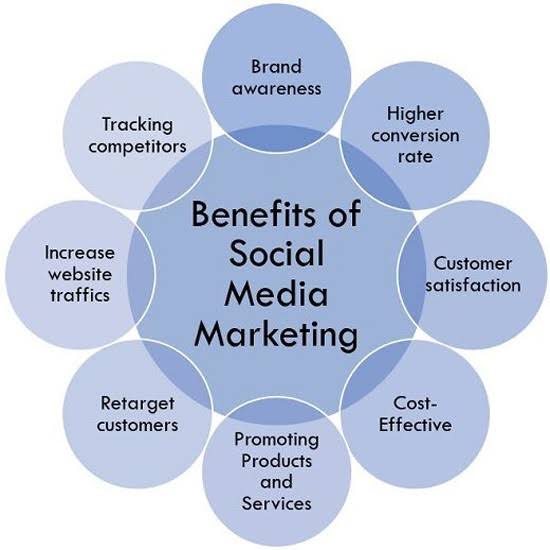
With such widespread usage and versatility, social media is one of the most effective free channels for marketing your business today. Here are some of the specific benefits of social media marketing:
- Humanize your business: Social media enables you to turn your business into an active participant in your market. Your profile, posts, and interactions with users form an approachable persona that your audience can familiarize and connect with, and come to trust.
- Drive traffic: Between the link in your profile, blog post links in your posts, and your ads, social media is a top channel for increasing traffic to your website where you can convert visitors into customers. Plus, social signals are an indirect SEO factor.
- Generate leads and customers: You can also generate leads and conversions directly on these platforms, through features like Instagram/Facebook shops, direct messaging, call to action buttons on profiles, and appointment booking capabilities.
- Increase brand awareness: The visual nature of social media platforms allows you to build your visual identity across vast audiences and improve brand awareness. And better brand awareness means better results with all your other campaigns.
- Build relationships: These platforms open up both direct and indirect lines of communication with your followers through which you can network, gather feedback, hold discussions, and connect directly with individuals.
The bigger and more engaged your audience is on social media networks, the easier it will be for you to achieve your marketing goals.
The essentials of a successful social media marketing strategy
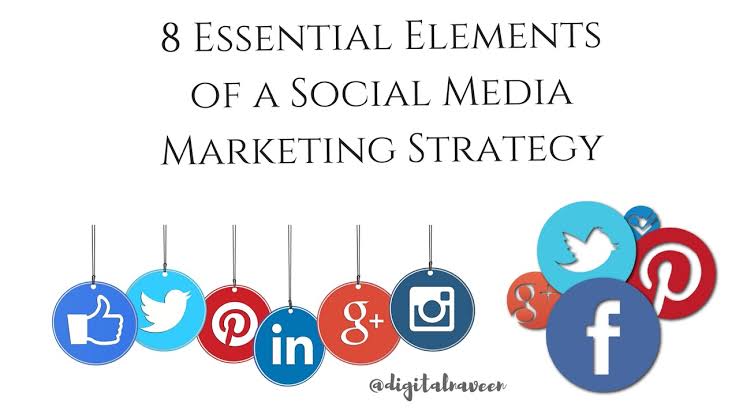
A successful social media marketing strategy will look different for every business, but here are the things they will all have in common:
- Knowledge of your audience: What platforms they use, when they go on them and why, what content they like, who else they’re following, and more.
- Brand identity: What is the message you want to convey to your audience? How do you want them to feel when viewing your content?
- Content strategy: While there is a level of spontaneity on social, you’ll need a structured content strategy to be able to have a consistent voice and produce quality content regularly.
- Analytics: Quantifiable insights will inform your strategy, including who you’re reaching, the right content to share, the best times to post, and more.
- Regular activity: Social media is a real-time platform. If you want to use it to grow your business, you need to post regularly, stay on top of engagements with your business, engage back, keep up with trends, and maintain accurate profiles.
- Inbound approach: Don’t use social media to pitch your business. Focus on adding value through useful and interesting content and building up those around you. This, in turn, will organically promote your business and others will promote it for you.
Creating your social media marketing plan
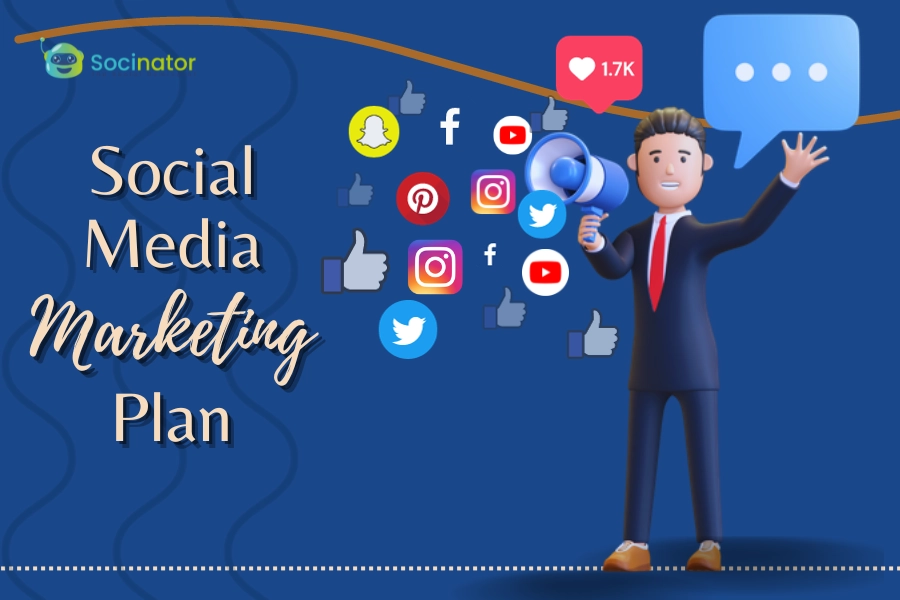
Now that you know the essentials of a social media marketing strategy, it’s time to put it into action. Your social media marketing plan is the roadmap to carrying out your strategy. It puts structure around your efforts so you can measure your success and make sure you’re spending your resources wisely. Here’s how to create your social media marketing plan:
- Choose your platforms: Choose based on your target audience, platforms popular for your industry, as well as your bandwidth. Only take on the number of platforms you can actively keep up with. You can always start with one and then add on more slowly as you get the hang of them.
- Set goals and objectives: These should be simple and task-like to start, like post once a day for a month, get your profiles set up, or do a competitive analysis. Once you get into a rhythm and gather insights, you’ll be able to set more specific and strategic goals like increase your following by X% or publish X [content types you’ve found your audience likes] per month.
- Report and adjust regularly: Use each platform’s analytics to identify which posts generate the most engagement, whether you’re getting more followers, and to see your audience demographics. Harness and scale up what works and nix what doesn’t.
Advantages of Social Media Marketing
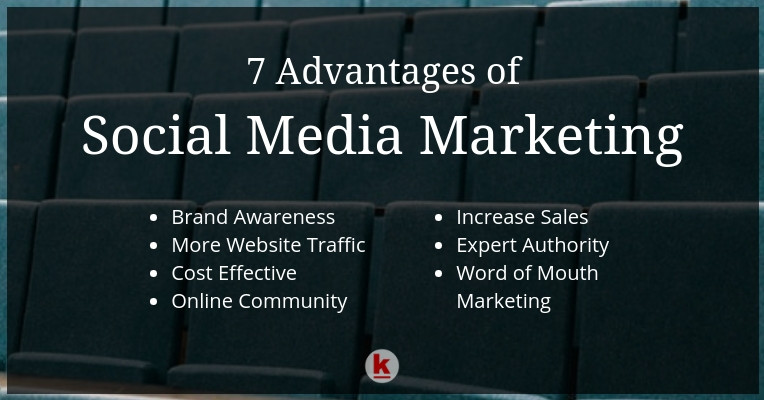
- Reach a wider audience. There are more than 3.6 billion users across all social media channels. A single post share can exponentially increase brand exposure.
- Improved customer satisfaction. Organizations don’t just market to customers on social media, they also interact with them. This can improve customer service and create one-to-one relationships.
- Cost-effective tool. When executed correctly, the cost of managing a social media program can be low. Once the knowledge, team and program strategy are in place, marketing teams find it easy to use with very little overhead.
- Increase website traffic. Social posts are a great way to drive traffic back to a brand website. Promoting blog content, landing page offers and more can entice users to click through and engage further with a brand.
- Gain better insights. Using the analytics and reporting features from each social media platform gives insight into who page followers are, what content they are interested in and how they like to engage with a brand.
Disadvantages of social media marketing
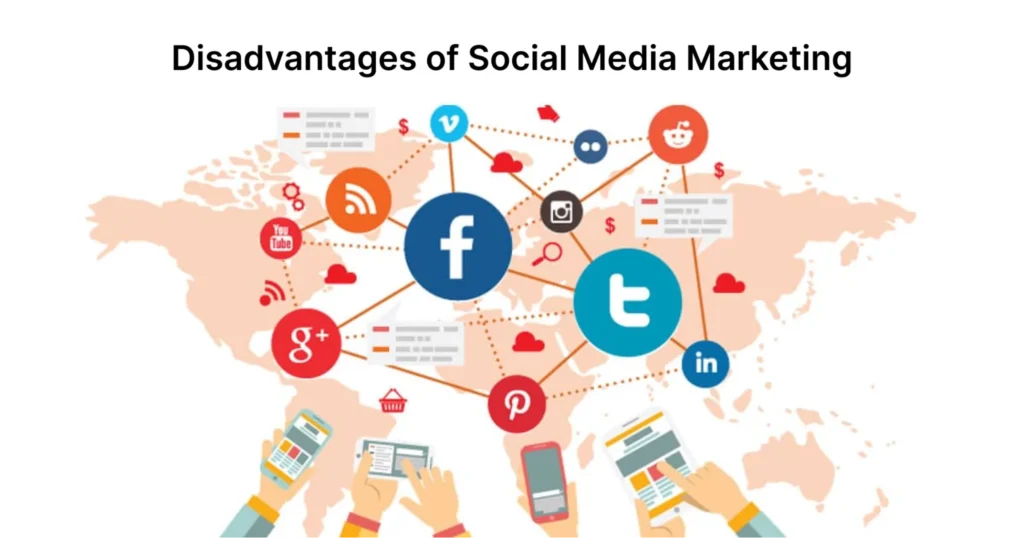
- Time-consuming process. A lot of time can be spent on social media campaigns to ensure they are effective. Marketing teams also need to constantly fill the calendar with new content and respond to inquiries. This can make it difficult for small marketing teams to tap into the full capabilities of SMM.
- Need qualified resources. It takes the right person or team to run a social media marketing program. Social media marketing programs don’t benefit from entry-level employees. Instead, skilled and seasoned social media marketers are key.
- Have to wait to see ROI. SMM is a long-term investment. Social media platforms yield a high ROI, but not in the form of immediate results. The success of an SMM program isn’t determined by one piece of content, but rather several over long periods of time.
- Competitor’s market research. Posting to social media is a public forum and everyone can see the content, including the competition. There is no workaround for this.
- Brand reputation is vulnerable. SMM can open a brand for public embarrassment and bad press. Negative reviews can be plentiful as customers take to social media to vent frustrations. And because of the public nature of the platforms, anything a company says or does will be seen and reacted to. Brands should expedite response times to mitigate this risk.
Limitations of Social Media Marketing

Social media marketing has several limitations, including:
- PrivacySocial media platforms require users to share private and public information. Social media accounts can also be vulnerable to security breaches, which can lead to client confidentiality breaches, intellectual property leaks, and policy violations.
- Low ROISocial media marketing can be a long-term strategy, so it’s not realistic to expect to see immediate results like increased website traffic or sales.
- Negative feedbackNegative consumer sentiment can quickly damage a brand. It’s important to monitor comments, replies, and how people share posts.
- Fake newsSocial media platforms can be a source of fake news, but businesses can use technology and knowledgeable staff to mitigate the risks.
- Time-consumingSocial media marketing can be time-consuming, requiring a lot of effort to create and manage content, respond to messages and comments, and monitor performance.
- EmbarrassmentPosts can go viral on social media, and people are quick to judge both the good and the bad.
- Deteriorating communication skillsExcessive social media use can reduce face-to-face communication skills, which can diminish empathy and genuine human connection.
How to create a social media marketing strategy
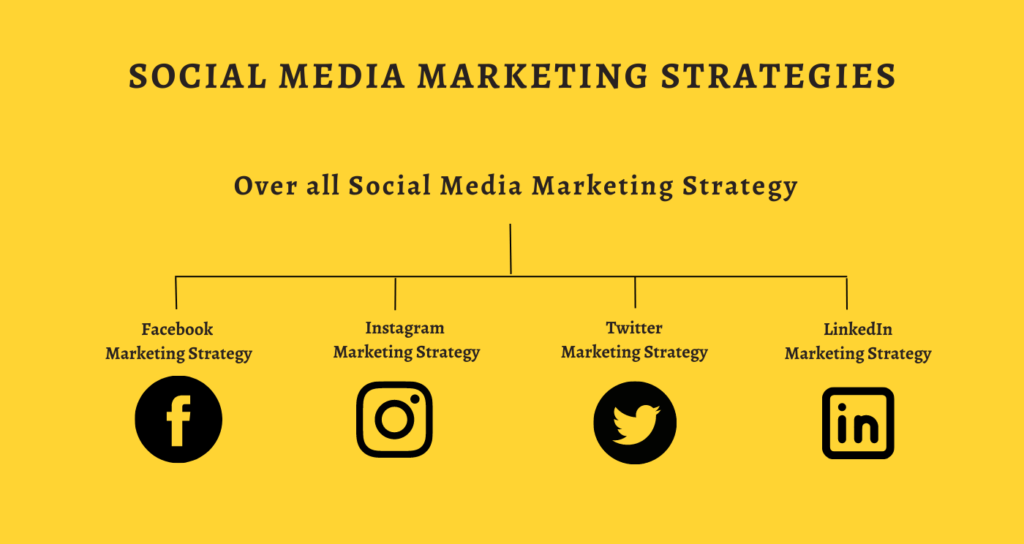
Here are the steps a company needs to take to build an effective social media marketing strategy:
1. Identify social media goals that align to the business goals
Start by setting goals that will act as not only a guide for how to use social media, but also a benchmark of data to measure against. Use a SMART goal format to find out what is realistic to accomplish. Examples of goals include the following:
- increase traffic to website
- drive more leads
- increase revenue
- grow audience
2. Research and define the target audience
It’s important to know who the target market is, what they care about and why they need a company’s products or services. Social media platforms are rich with data about users, so this exercise can be done without a substantial market research project. Knowing demographic information and who follows the social channel are great starting points.
It’s also important to know that different platforms attract different users. Knowing what social channels a company’s target audience is on enables them to choose which channels to invest time and resources into.
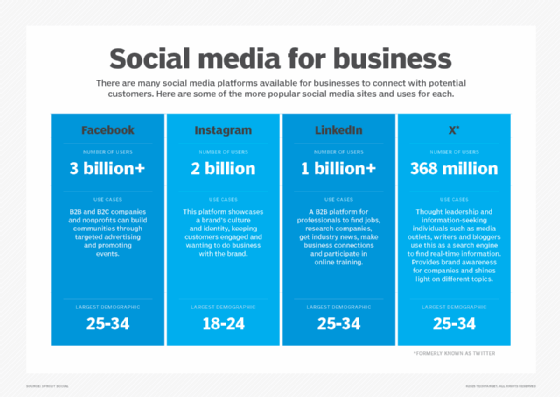
3. Perform a competitive assessment
Knowing what the competition is doing enables marketing teams to identify what is working well and what is not for the competition. This provides industry insights as well as opportunities to bring a product or message to market.
Social listening tools can also help brands set up different monitoring streams for competitive content and industry keywords.
4. Create and curate relevant content for the channel
Knowing the goals, audience and competitive landscape will help determine the type(s) of content that brands need to create. Engaging content comes in different forms and media. It can be company generated, curated from elsewhere to share industry news or other thought leadership pieces.
Businesses should publish content frequently and consistently to develop an engaged follower base. Brands can post promotions to increase engagement. They can also create posts that show a more relatable and human side to the organization.
5. Be timely with posts and responses
Posting when convenient for a business isn’t always convenient for customers. Taking advantage of the best times to post for engagement is information that can be collected from analytics. Then organizations can schedule posts ahead of time using available publishing tools. Timeliness of the content is also important as the news cycle moves fast.
Another element of being timely on social media is response time. If customers engage with a brand on social media, they also expect a quick reply. A brand can build authority and respect with its clientele through these one-to-one relationships.
6. Gain buy-in and support from others in the organization
Marketing departments need to engage other departments and stakeholders within an organization. Marketing can learn a lot from sales to inform future social campaigns, but sales can also benefit from marketing’s reach. Sales and marketing alignment is great, but senior stakeholder support is also a necessity.
Supporting other departments’ efforts is a common sign of a strong social media program. Every department in a company can benefit from social support, but HR is usually the next best place to partner with. Social media can be a recruitment tool and brand builder for prospective employees.
7. Measure and optimize
The last element of building a successful social media marketing program is to measure what works and what doesn’t. Organizations should monitor the following:
- posts that get top engagement;
- followers that continue to buy; and
- ads that yield the highest ROI.
The best social media marketing platforms for business
The best social media marketing platforms for business include Facebook, YouTube, Instagram, LinkedIn, Twitter, TikTok, and Snapchat. Different social media marketing sites require different approaches, so here’s a brief overview on each one—its user base, main vibes, pros, cons, and content types.
You can get a comprehensive look into each platform here: The Biggest, Baddest, Most Popular Social Media Platforms and How to Wield Their Power.
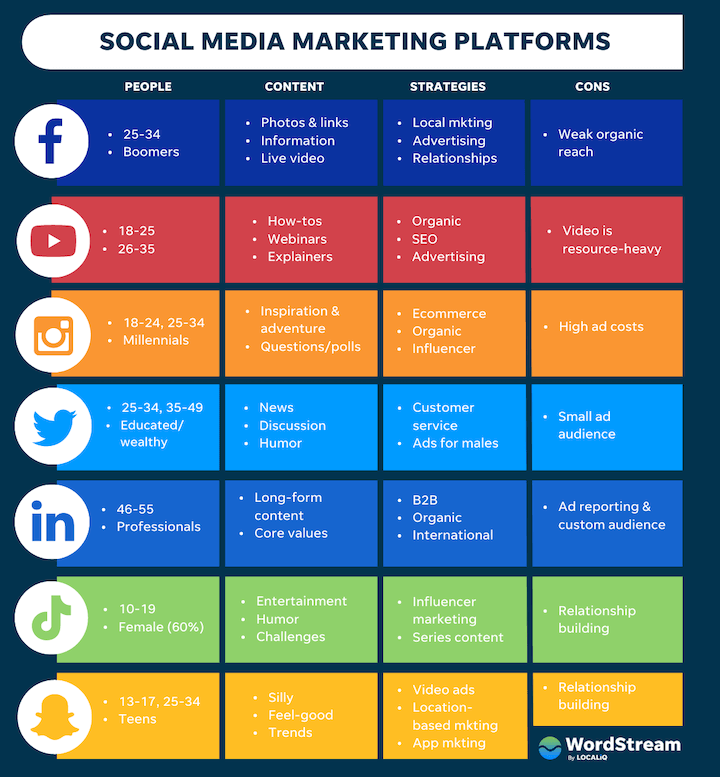
Facebook is the largest social media platform globally as well as one of the biggest local business directories. People of a diverse range of age groups use it to communicate with friends and family, participate in groups and forums, find and visit businesses near them, and follow brands. Facebook is a great social media marketing platform to:
- Build relationships with current customers
- Announce hours changes, events, and milestones
- Hold discussions and live streams
- Market to baby boomers
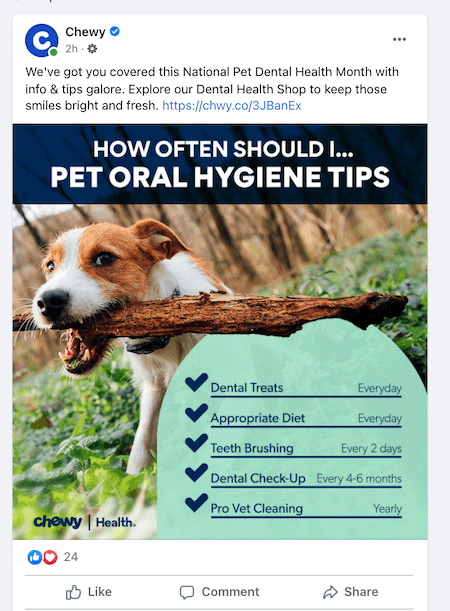
Organic reach on Facebook is limited, so if you’re looking to generate leads or find new audiences, Facebook advertising is your best bet.
More resources for social media marketing on Facebook
- 22 Budget-Friendly Facebook Marketing Tips
- How to Promote Your Facebook Business Page for Free
- Facebook Advertising Cheat Sheet
- 62 Facebook Post Ideas to Increase Engagement
YouTube
You may not think of YouTube as a social media marketing channel, but it fits the bill: you can post videos to your channel; share, comment on, and like other videos, and follow other accounts you like. Plus, you have a curated feed in your homepage with recommended videos. The key to social media marketing on YouTube is not to try to “go viral,” but to add value. It’s best for:
- Tutorials, how-tos, and explainer videos
- Shoppable YouTube live streams
- Advertising (video ads and display ads on the platform)
- SEO (video is dominating the “how to” SERP!)

More resources for social media marketing on YouTube
- 8 YouTube SEO Tips to Rank Higher in Search
- 6 Tips for More Profitable YouTube Advertising
- How to Use YouTube to Promote Your Business
Though it came onto the scene years after LinkedIn and Twitter, Instagram quickly surpassed those platforms and reached one billion monthly active users in 2018. It’s popular for its diverse content formats, including Feed posts, Stories, Lives, Reels, and IGTV. People use Instagram to follow influencers and brands they buy from and who support their personal values. Create your Instagram bio and then use it for:
- Social shopping
- Influencer marketing
- User-generated content
- Company culture
The cost of Instagram ads is generally higher than on Facebook, but the good news is that organic reach is also higher.
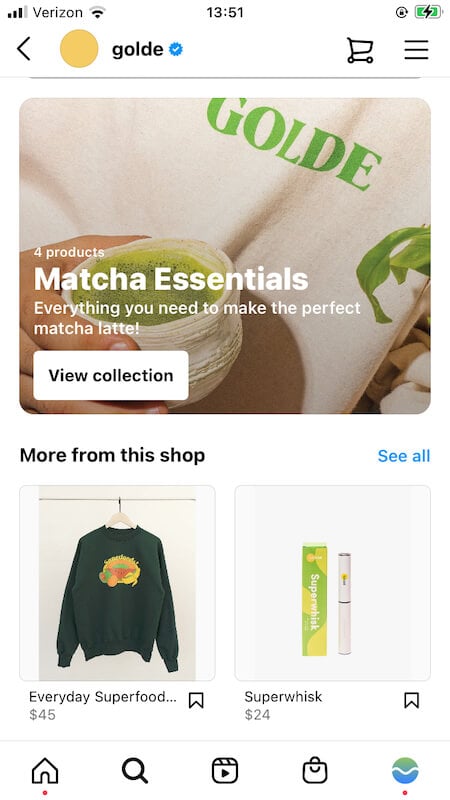
More resources for social media marketing on Instagram:
- Instagram Marketing Strategy 101: 4 Steps to Success
- 19 Instagram Reels Ideas to Grow Your Brand
- 5 Instagram SEO Tactics to Rank Higher in 2022
LinkedIn may be a professional network, but it’s also an inspiring community that celebrates leadership, learning, and core values. So in addition to using it to network, find prospects, and share industry insights, it’s also a great place to express your company culture and build your personal brand in parallel with your business brand. There are tons of LinkedIn company page features to take advantage of, so take care when building your page. LinkedIn is a great platform to:
- Attract top talent
- Network with partners, peers, and customers
- Share company milestones and culture
- Post industry news and insights
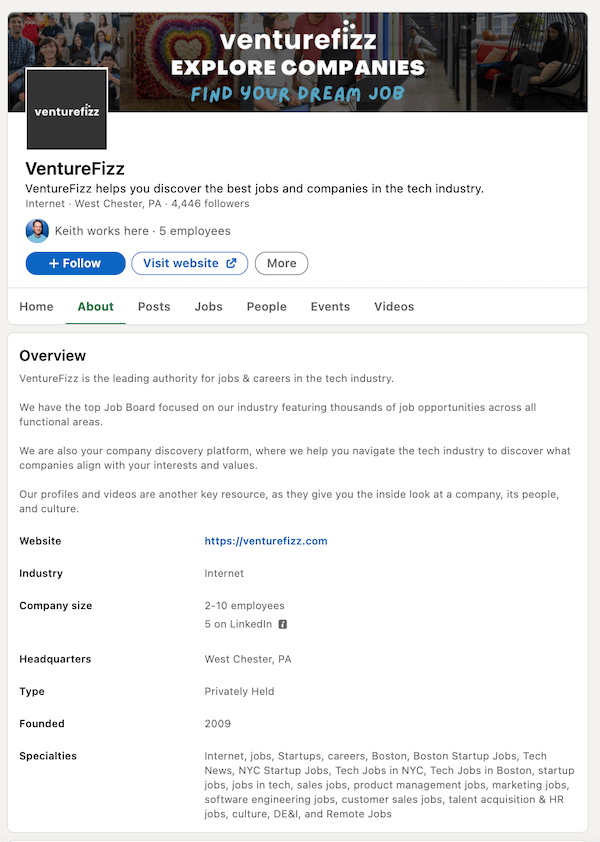
More resources for social media marketing on LinkedIn:
- A 3-Step Process for Generating Leads on LinkedIn
- 10 LinkedIn Company Page Features You Need to Be Using
- The Complete LinkedIn Advertising Cheat Sheet
Twitter is a beautifully tangled network of quick thoughts, useful tidbits, and energized discussions. You should be regularly active on every social media platform, but it’s especially important here. Many people use Twitter to get news, follow brands, and get customer service. Be sure to retweet when a customer has something nice to say about you, and don’t forget to answer people’s questions when possible. For effective social media marketing on Twitter, you may want to:
- Follow influencers to keep up with news and trends.
- Share a story through a series of Tweets in one thread.
- Make yourself available for customer service and FAQs.
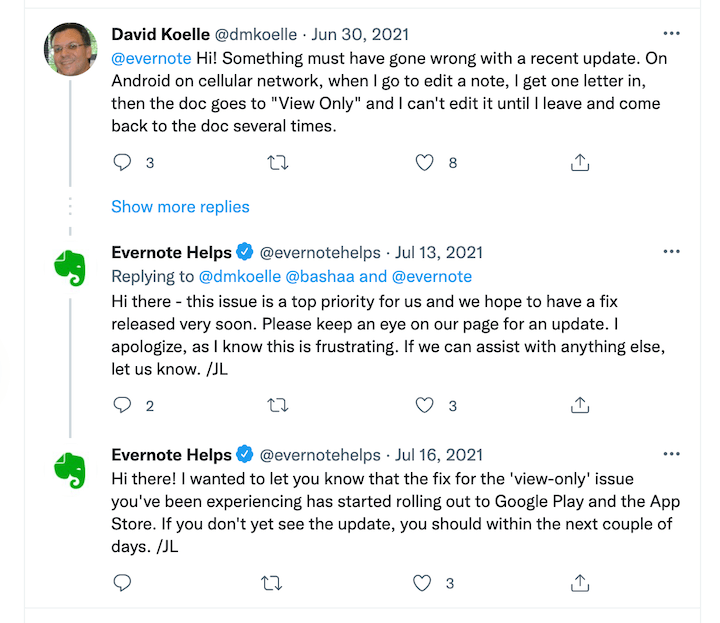
More resources for social media marketing on Twitter:
- How to Find Your Old Tweets
- 8 Twitter Features to Take Advantage of Now
- 19 PPC Influencers You Need to Be Following
Snapchat
Snapchat isn’t just for teens. Its largest age group (75%) ranges from 13-34 and with Snap Maps, geofilters, and its partnership with Gannett, it’s more locally-focused than you might think. While you can’t build relationships on the platform, you can build an audience through fun images and short videos. Use Snapchat for:
- Location-based marketing
- App marketing
- Feel-good content
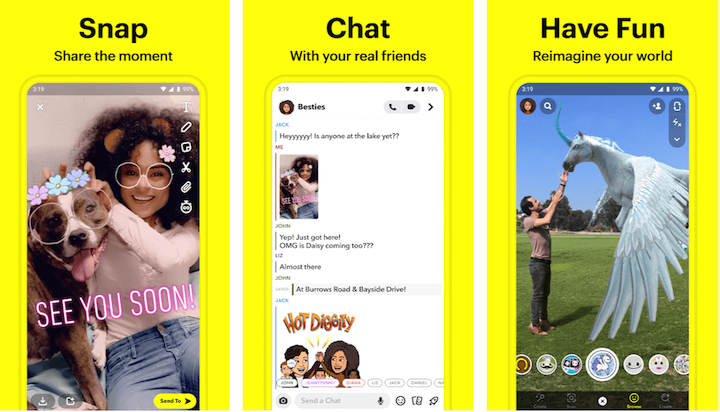
More resources for social media marketing on Snapchat:
TikTok
TikTok is the fastest growing social media platform of all time, taking only five years to reach one billion monthly active users. While it’s known for dancing, there are countless popular categories on the platform that continue to grow. Businesses are finding ways to use it as a marketing channel, but just remember, the primary reason people use TikTok is for entertainment, so make sure your videos align with that. Use TikTok to:
- Participate in trending challenges
- Post funny and inspiring videos
- Be relatable

More resources for social media marketing on TikTok:
- The Best Time to Post on TikTok & How It (Surprisingly) Compares to Instagram
- 9 Data-Backed Reasons to Be Marketing on TikTok
- 5 Simple Steps to Set Up Your TikTok Ads
Key Components of a Good Social Media Marketing Strategy

While it may be tempting to post on a few social media platforms whenever you feel like it, doing so isn’t recommended. To truly make the most out of social media marketing and increase its chances of success, you need a solid social media strategy.
Put simply, a social media strategy is a game plan that lays out your social media goals, the tactics you’ll use to achieve them and the metrics you’ll track to measure performance. Here are the key components of an effective social media strategy:
- Audience research: Before you post anything, you should have a strong understanding of your particular target audience. Answer questions such as, what platforms do they use, what type of content do they prefer, and who else do they follow.
- Brand identity: Determine how you’d like to position your brand when you post on social media and interact with your followers. Think about the messages you hope to convey.
- Content strategy: Content strategy describes how you’ll use content to grow your brand and attract your audience on social media platforms. The more specific your plan is, the more likely it will succeed.
- Analytics: Social media analytics is a process where you collect and analyze data from your social media platforms so you can measure performance and determine how to improve your strategy. Without it, you won’t know whether or not what you’re doing is working.
- Ongoing activity: Along with most types of marketing, social media marketing is not a one-time deal. You’ll need to post on it, engage with your followers and optimize your profiles on a regular basis.
Keep in mind that in addition to your social media strategy, you also need a professional business website. This way, those who discover your business via social media can go to your website to learn more about what you offer. If you don’t already have a site, learn how to design a website. If you want a very easy way to build a site quickly and affordably, consider using one of the best website builders.
Social media marketing services
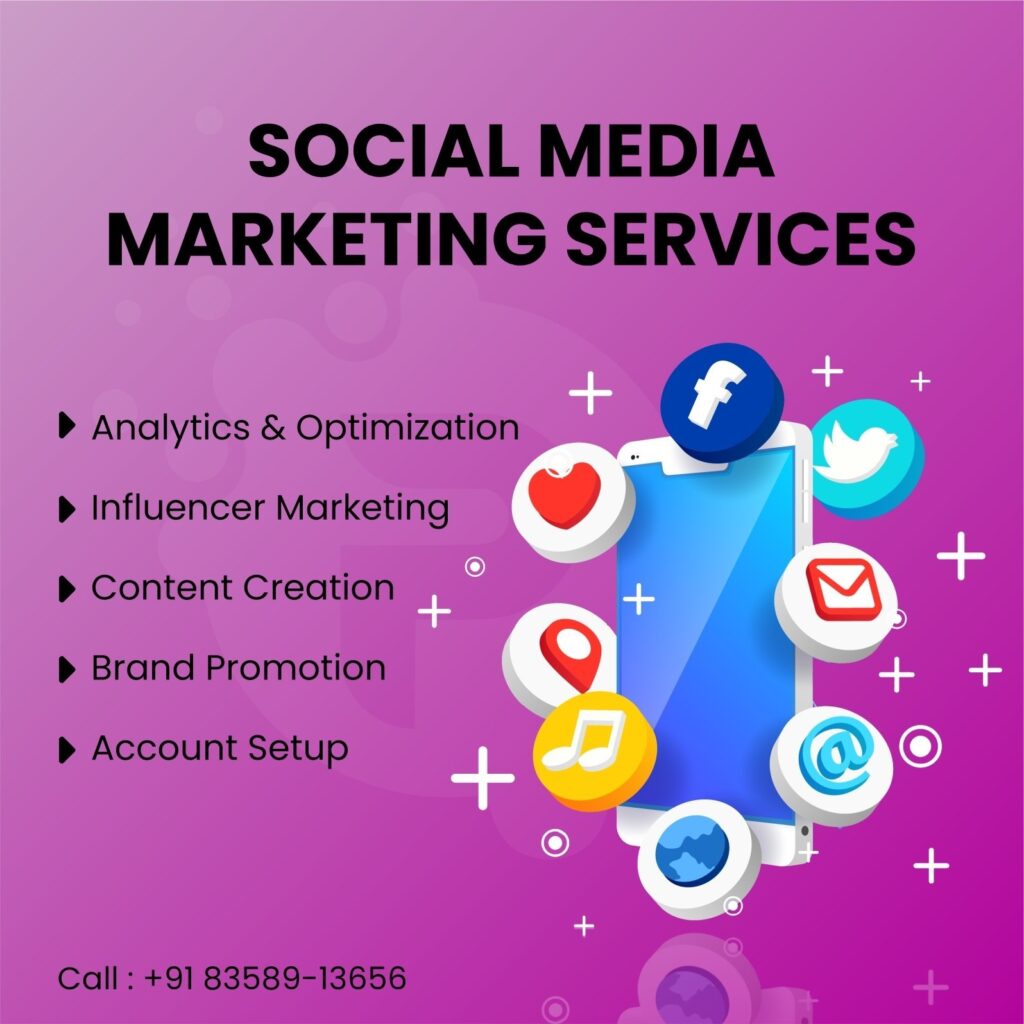
As free and easy as each platform may be, a solid social media marketing strategy requires multiple platforms and often a mix of organic and paid methods. This can be resource-heavy, and while it’s a good problem to have, the more you grow your audience using social media, the harder it will be to keep up. Social media marketing services come in all kinds of shapes and sizes to help businesses get the most out of social media. For example:
- Social media management software: Social media management platforms like HootSuite and Sprout Social use proprietary technology to help more experienced social media marketers streamline their processes and get advanced analytics.
- Social media marketing agencies: Some agencies specialize in social media marketing only, like Akvertise or even just paid social advertising only.
- Digital marketing agencies: Just as one platform doesn’t do it for social media marketing, one channel doesn’t do it for overall marketing. Digital marketing agencies can help you to incorporate social media marketing into your broader strategy that includes email, website, SEO, and more.
- Hybrid services: Some offer a mix of the above. For example, LOCALiQ’s social advertising offerings use proprietary technology to manage your strategy and allow you to focus on social alone or as part of a broader plan.
Social Media Marketing Tips

Ready to get started with marketing on social media? Here are a few social media marketing tips to kick off your social media campaigns.
Create diverse content
Consistent with other areas of online marketing, content reigns supreme when it comes to social media marketing. Make sure you post regularly and offer truly valuable information that your ideal customers will find helpful and interesting. This includes:
- How-tos, quick tips
- Local and industry news
- Data and insights
- Polls, questions, contests
- Updates and announcements
It also means making use of the variety of formats social media offers, including images, videos, stories, live streams, online stores, and more.
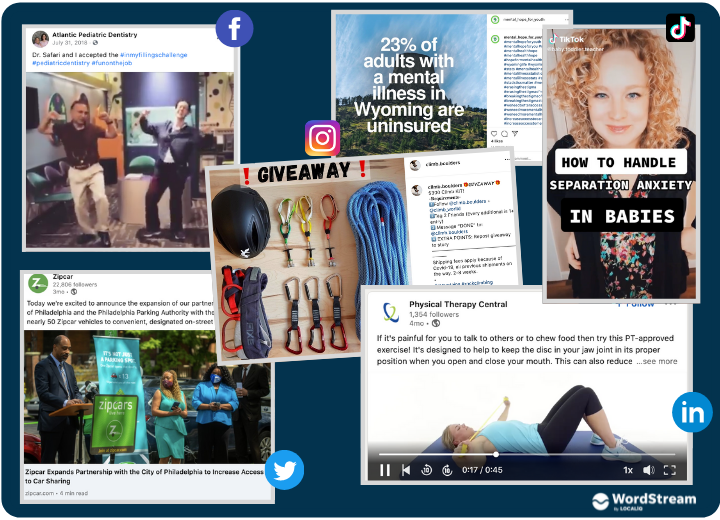
For help with creating awesome social media content:
- Check out our guides on Instagram Live, Facebook Live, and YouTube Live.
- Try out these 6 Epic Instagram Story Hacks You’ll Wish You Knew Sooner.
- Use templates! Like these Holiday & Christmas Social Media Post Templates.
Stay consistent
Using social media for marketing enables your business to project your brand image across a variety of different social media platforms. While each platform has its own unique environment and voice, your business’s core identity, whether it’s friendly, fun, or trustworthy, should stay consistent.
Don’t just post—participate
In other words, don’t just log in once a month to schedule out all your posts. Social media channels are communities. You need to pay attention to who’s engaging with your content and engage back—respond to comments, like, share and comment on their posts, run live streams, post polls and real-time questions to spark discussions, and repost others’ content.
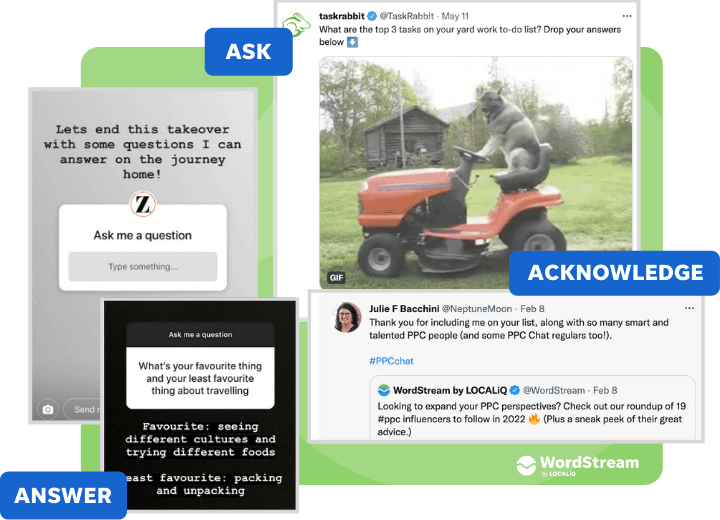
Use content creation tools
Don’t let anyone tell you that Instagram is the most visual social media platform. They all are! If you want to stand out in a person’s feed, you need to accompany your posts with attractive visuals—photos, illustrations, text turned into art. Content creation tools like Freepik and Canva have templates and features that allow you to quickly create visuals that look professional, have your logo on them, and are consistent with your brand.
Repurpose, repost, recycle
Social media is a crowded place, so if you want to gain traction with your audience, you need to post great content regularly. The secret to doing this? The three Rs:
- Repurpose: Create a Facebook post from a customer review, splice up a blog post into a series of Tweets, distill a case study down into a customer spotlight on Instagram; turn a webinar deck into a carousel post on LinkedIn. The possibilities are endless.
- Repost: To be done in moderation, but a great way to fill gaps in your content calendar. Repost on Instagram and retweet user-generated and influencer content. You can also curate content from authoritative sources and share those links in your posts.
- Recycle: Post your TikTok videos and Instagram Reels to YouTube; re-share your top-performing blog posts every month to get in front of new followers; add your Facebook Live recordings to your YouTube channel.
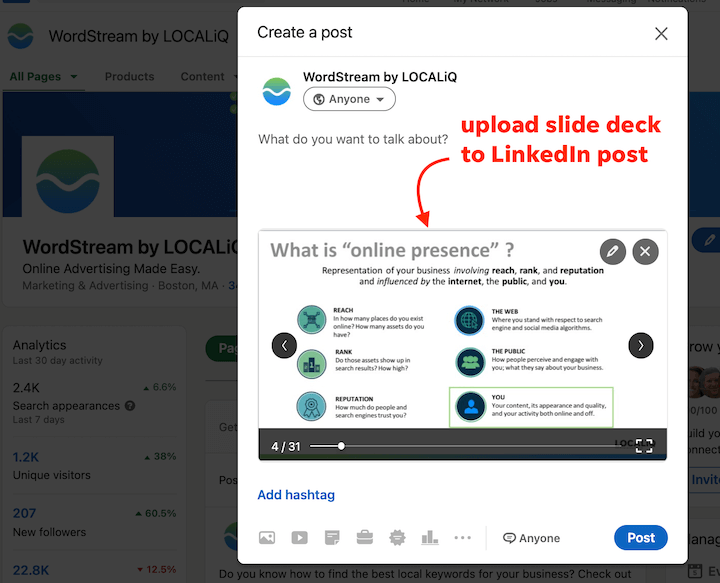
Curate your own feed
We’re always looking for ways to show up in others’ feeds, but we forget that there is value to be derived from our own. Follow your competitors so you can keep tabs on them, get ideas you can adapt to your own strategy, and identify gaps you can fill. Follow influencers to stay on top of trends and educate yourself. Follow brands that share your values or that have great content strategies for inspiration and outside the box ideas.
Measure success with analytics
You can’t determine the success of your social media marketing strategies without tracking data. Google Analytics can be used as a great social media marketing tool that will help you measure your most triumphant social media marketing techniques, as well as determine which strategies are better off abandoned. Attach tracking tags to your social media marketing campaigns so that you can properly monitor them. And be sure to use the analytics within each social platform for even more insight into which of your social content is performing best with your audience.
Try paid social
Among the many reasons to advertise on social media is that it is a highly cost-effective way to expand your reach. If you play your cards right, you can get your content and offers in front of a huge audience at a very low cost. Most social media platforms offer incredibly granular targeting capabilities, allowing you to focus your budget on exactly the types of people that are most likely to be interested in your business. Below are some tips and resources for getting started with paid social media marketing:

Free guide:
Conclusion

Social media marketing is a dynamic, powerful tool for businesses of all sizes. By understanding your audience, crafting compelling content, and leveraging the strengths of each platform, you can create impactful campaigns that drive growth and engagement. The key is to remain adaptable, monitor trends, and consistently refine your approach to achieve lasting success in the digital landscape.
Social media marketing has evolved into a cornerstone of modern business strategy, offering unparalleled opportunities to connect with audiences, build brand loyalty, and drive growth. By leveraging platforms such as Instagram, Facebook, LinkedIn, and TikTok, businesses can reach diverse demographics with targeted, engaging content.
The dynamic nature of social media requires staying updated on trends, analytics, and consumer behavior. Authenticity, creativity, and consistency are key to standing out in a crowded digital landscape. Additionally, integrating tools like influencer partnerships, paid ads, and data-driven insights ensures campaigns are both impactful and measurable.
However, success is not solely about visibility but fostering genuine relationships with customers. Interactive content, timely responses, and community engagement build trust and loyalty, turning followers into advocates.
As algorithms and user preferences continue to evolve, businesses must remain adaptable, experimenting with new formats like short-form videos, live streaming, and user-generated content. Ultimately, social media marketing is more than a promotional tool—it’s a bridge that connects brands to their audiences, cultivates meaningful interactions, and drives long-term value. By staying authentic and strategic, businesses can thrive in the ever-changing world of social media.
